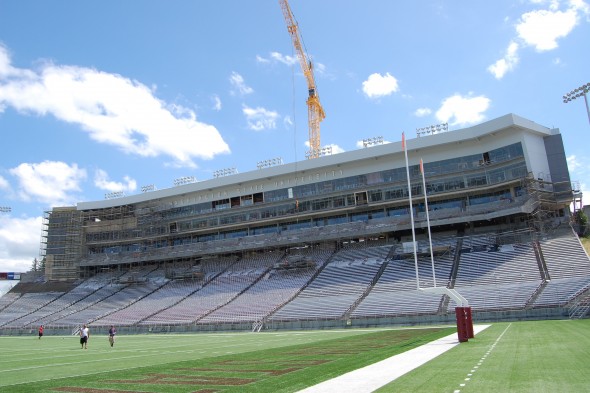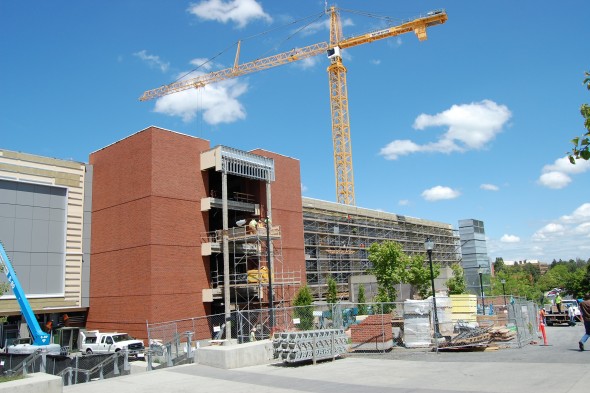
PULLMAN — Time for Washington State University’s economically obsolete Martin Stadium to catch up with the rest of the football yards of the suddenly wealthy Pac-12 Conference.
No strangers to facility improvements (see University of Oregon’s Autzen Stadium), WSU athletic director Bill Moos and senior associate AD John Johnson flew cross-country in April 2011 to tour state-of-the-art stadiums in the Big 12 and SEC. Stops included Nebraska, LSU, Texas A&M and Texas Tech.
The trip solidified design of the $80 million project, the first phase of which will be seen this season — an 88,000-square-foot upgrade on the south side of Martin Stadium.
“We tried to take the best of what we saw on the tour,” Johnson said of the decision to build an enormous three-story structure atop the grandstand. “We saw what worked and what didn’t work and got feedback from the folks who run those facilities and what they would change.”
The result: a new press box, three radio booths, a television booth and a game operations room. And most important — 1,180 club seats.
“We included premium seating in this project, which is the bulk of what the space is,” Johnson said. “We have outdoor club seating. We have 42 four- and six-person loge boxes in that area that’s outside but under cover, and then an 11,000-square-foot club room that has high-end concessions, beverages, etc.”
The second level includes 21 luxury suites priced between $30,000 and $50,000 per year that seat from 12 and 24 patrons. Suites are sold out for the 2012 season that begins with the Sept. 8 home opener against Eastern Washington. Meanwhile, WSU fans have purchased more than 700 club season tickets priced between $1,700 and $2,500 a year. Those wanting to scoop up single-game tickets in the club section will need to throw down $300 per seat.
Designed by AECOM Technical Services and ALSC Architects of Spokane, the structure figures to dramatically affect Martin Stadium’s atmosphere. In 2003, Sports Illustrated ranked the venue among the Top 25 toughest places to play in the country. According to Johnson, the stadium’s location in the middle of campus creates a unique setting unlike any other campus in the country.
In other words, it might get loud.
“It encloses the stadium more,” Johnson said. “I believe it will create more noise inside the stadium, more of a dynamic environment. It’s already an intimate setting. It was always a very loud stadium anyways.”
The “Southside Project” is still on time and under its $80 million budget. A projected $15 million in leftover funds from the two-phase renovation will go toward a football operations facility dubbed the “West End Zone Project.” Johnson said the athletic department is still pushing through the development portion of the process but plans to have a design ready to present to the Board of Regents by fall. Estimates for phase two have construction bonds priced around $65 million, putting the total cost of the Martin Stadium makeover around $125 million.
The University of Washington is undergoing a major teardown and build-up of Husky Stadium, much of which dated to 1920. The $250 million project will open in 2013 after this season at CenturyLink Field downtown.
According to thecougarfootballproject.org, the renovation is funded entirely through premium seating donations, which will nearly double ticket revenue, and the lucrative new Pac-12 television contract set to begin in August. Fans who want a spot in the club section deposited $500 per seat before purchasing season tickets. The sold-out loge boxes cost $1,000 before factoring in season ticket prices ($10,000 for a four-person box, $15,000 for a six-person box) while the luxury suites called for a $5,000 down payment. Loge boxes and luxury suites contracts included options for boosters to sign a three-, five- or seven-year lease with a right of first refusal at the end of the lease term.
Early renderings of the next renovation phase garnered positive feedback, according to Johnson. If the regents approve, the football-only operations building will begin construction after the Apple Cup. Slated for completion by the 2013 season, the facility would push the scoreboard to the east end zone while eliminating about 2,000 seats in the west end zone. It would include a weight room and football locker room, offices for Mike Leach and his staff and a place for team meetings.
The new building would drop Martin Stadium’s capacity, already the Pac-12’s smallest venue, to under 33,000 seats. If the Cougars mount a resurgence under the direction of Leach, stadium renovations could be far from over. Moos has said he envisions the final stadium capacity to eclipse 40,000.
“We have conceptual drawings from early master-planning exercises,” Johnson said. “If we needed to add seats we would add a deck in the east end zone.”
However, the thought of increasing stadium capacity is far from Johnson’s mind. The Cougars struggled to attract fans to Pullman during Paul Wulff’s 9-40 tenure over the past four seasons. In last year’s 30-27 home loss to Utah, WSU drew just 16,419 fans with their bowl hopes still alive.
“We’re going to fill the stadium first before we look at other stages,” Johnson said. “Right now we’re focused on finishing the South Side Project and our football operations building.”
Martin Stadium’s evolution has fans and boosters wondering if Moos will cap his public bid to rebrand WSU athletics by changing the stadium’s name. Former Gov. Clarence D. Martin graduated from the University of Washington.
Johnson seemed open to change, should someone be willing to pay for naming rights.
“Clearly if the right situation came up and there is an opportunity to rename the stadium but still maintain the legacy of the Martin family… we would continue to honor that name as well.”

For a look at the stadium improvements, go to thecougarfootballproject.org.

4 Comments
I love the Cougs and think Moos and Leach were inspired hires, and I’m hoping they’ll start filling those 33,000 affordable seats outside before they even think about expanding Martin Stadium to 40,000. You cannot be competitive in a major conference like the PAC 12 with gatherings of less than 20,000 people, no matter how loud they are. That’s Mountain West (or even WAC) territory. When you get 16-17,000 for a conference game against Cal or Utah, that’s downright embarrassing. Even Montana’s FCS program gets better support playing against the likes of Sacramento State or Northern Arizona.
No doubt the hire of Moos and Leach has inspired Cougar fans across the state. Moos sensed the wide-spread apathy directed at Cougar football over the past three years and knew it was time to make a splash hire to accompany the facility upgrade.
I love the Cougs and think Moos and Leach were inspired hires, and I’m hoping they’ll start filling those 33,000 affordable seats outside before they even think about expanding Martin Stadium to 40,000. You cannot be competitive in a major conference like the PAC 12 with gatherings of less than 20,000 people, no matter how loud they are. That’s Mountain West (or even WAC) territory. When you get 16-17,000 for a conference game against Cal or Utah, that’s downright embarrassing. Even Montana’s FCS program gets better support playing against the likes of Sacramento State or Northern Arizona.
No doubt the hire of Moos and Leach has inspired Cougar fans across the state. Moos sensed the wide-spread apathy directed at Cougar football over the past three years and knew it was time to make a splash hire to accompany the facility upgrade.